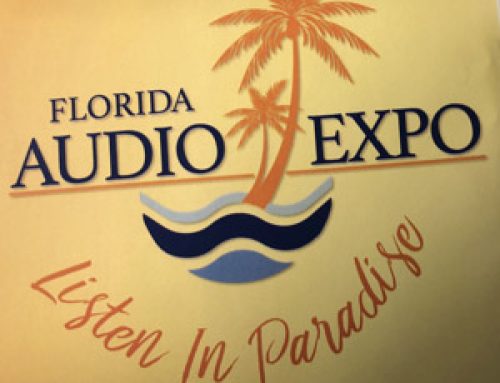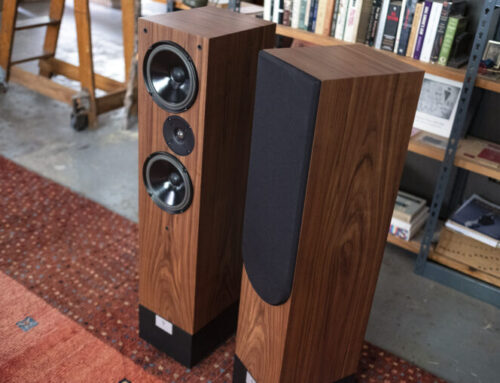 Listen to some audio commentators and you could be forgiven for feeling that single-ended amplifiers are the truth, the light and the only way. Indeed, the quasi-religious fervour that this technology attracts brooks no dissent – bizarre when you consider that it was last current over sixty years ago. This topology and only this topology delivers sound so natural that it renders all else false, music so powerful that mere Watts become irrelevant. Are we to assume that the development of all intervening technology was just a string of gigantic mistakes? Apparently so.
Listen to some audio commentators and you could be forgiven for feeling that single-ended amplifiers are the truth, the light and the only way. Indeed, the quasi-religious fervour that this technology attracts brooks no dissent – bizarre when you consider that it was last current over sixty years ago. This topology and only this topology delivers sound so natural that it renders all else false, music so powerful that mere Watts become irrelevant. Are we to assume that the development of all intervening technology was just a string of gigantic mistakes? Apparently so.
In fact, so universal has this crusade become (they’ll be burning old copies of Wireless World soon, swiftly followed by a few reviewers and editors) that the odd voice of moderation has risked being swept away by the flood. But, unfortunately our experiences with a number of highly regarded single-ended designs have left us cold. Yes, as far as it’s fair to generalise, they are warm and snugly and they breath across the midrange, but their lack of grip at frequency extremes, and an almost generic incapability to time bass notes robs music of drama and its sense of performance.
So, are we anti single-ended? Far from it. We call it the way we hear it. But we’re not prepared to write off an entire technology on the basis of a few bad experiences. One of the big problems that has emerged in hi-fi in the last twenty years, in direct proportion to the influence of marketing on product development, is the concept of the ‘magic ingredient’ and the label that goes with it. The first really obvious example of this was the metal dome tweeter. First there was the SL6, then the 600; all those lovely diagrams with lasers and soon you couldn’t sell a speaker without a metal dome. So much so that established speaker designs were hastily re-jigged to accept some new wonder tweeter and a ti designation. Next came bi-wiring, and since then there’s been similar stupidity over everything from chipsets in CD players to materials in cables. With the benefit of 20×20 hindsight how many of you would buy any speaker today just because it uses a metal dome tweeter?
In fact, there’s something of a backlash now, with soft domes making a real comeback. The problem with single-ended amplifiers is that in too many cases it really is just a label. A lot of manufacturers are producing them because they feel that they have to, rather than because they believe in the technology. The simple fact is that there’s no such thing as a universal panacea, and an amplifier, properly used, is either good, bad or somewhere in between. Just because it contains single-ended circuitry and direct heated triodes is no guarantee of quality. In hi-fi it’s not what you use but how you use it that matters, and buyers forget that at their peril.
Which brings us to the Border Patrol 300B SE(WE), an excellent and distinctive amplifier that also happens to be single-ended. Originally intended to partner the huge and extremely efficient Living Voice Air Partners, single-ended circuitry was chosen as the most appropriate topology and back in 1991, this was probably the first use of single-ended 300Bs in the UK. It was the limitations at the frequency extremes of that original design that led to the development of the sophisticated external power supply a simplified version of which soon became popular as a modification for other valve amps. But it’s the full on three stage supply that remains at the heart of this amp. Which explains why the Border Patrol is a two box design, the non magnetic, wood framed chassis being linked by a heavy umbilical to the large external power supply. The amplifier proper is sparsely populated, with just four valves and four transformers. The socketry is all mounted vertically on the back of the top-plate, arid whilst that may not make for the tidiest cable dressing, hook-up is an absolute doddle. I definitely approve. Inputs are phono sockets, whilst single sets of 4mm binding posts are provided for each channel, with separate taps for 4 and 8 ohm loads. The amplifier sits on large cones, so be careful dragging it around, although thankfully the external power supply keeps its weight nice and manageable (I wouldn’t want to pick this up if it was all in one box).
The only complication with set-up involved earthing, so hum free operation may demand a little care, but your dealer should sort this out for you anyway. I ended up running the Border Patrol from a floating earth. Otherwise, operation was completely fuss free throughout the review period. Incidentally the WE in the amps designation refers to the Western Electric valves with which it arrived. A Ł500 option, I didn’t hear the amp in standard trim, but independent observers reckon that they’re worth the Ł250 a valve premium, so who am I to argue? Otherwise you get a pair of JJ 300Bs from Slovakia, built on ex-Tesla machinery which Border Patrol reckon represent the best of the rest.
And the Border Patrol doesn’t just look different. As you’ve probably already guessed the sound isn’t exactly run of the mill either. Taut, crisp and solid are not words that apply to the vast majority of single-ended triode amps, but that’s exactly how the 300B SE(WE) sounds. Lovers of the lush, blowsy and indistinct character that so many single-ended advocates seem to like are to be sorely disappointed.
There are no rose tinted specs, slurred and rolled off frequency extremes or over stuffed harmonics here. In fact, for the first time in my experience (the SAP Anniversary excepted), I’m listening to an amplifier with the linearity and directness that are supposed to be single-ended’s great virtues. Indeed, the Border Patrol might have dipped out on the syrupy sweetness part of the single-ended deal, but it delivers the “real sense of power” with consummate ease, another area in which most of its compatriots fail to live up to their billing. Instead of lush and overblown, the 300B SE (WE) is wonderfully (and correctly) rich. Instruments have a natural weight and colour, and voices, especially tenors, have tremendous authority and a real sense of substance. Bjoerling’s tone and power were awesomely barrel chested (Cavalleria Rusticatia RCA VIC6044), while Milanovs magical poise and control (La Forza Del Destino RCA SER 4516/7/8/9) forced you to question just why she is so consistently overlooked when people discuss great sopranos. There is absolutely no doubt that this amp is outstandingly natural in tonal and harmonic terms, giving the performer, be it instrumental or vocal, a tangible presence in the room.
 All of which is useless if the whole thing doesn’t hang together, so often a single-ended Achilles heel. Thankfully the Border Patrol has plenty of grip in the nether regions, and keeps things moving purposefully along. Take the high energy drive of ‘Look Down, Look Down’ (Martin Stephenson and the Daintees Bout to Bolivia KWLP5); from the jaunty opening phrase to the layer on layer of guitar and drum rolls as the song builds to its climax, the amp never fails to step up a gear an never loses control. The chopped guitar is tactile and full of direction, the twinned bass and bass drum notes are easily separated. And the voice? I think the word is direct. Unmistakably Martin Stephenson, the singer is never drowned no matter how frantic the band, never submerged in the (beautifully separated) backing vocals; the lyrics never lose that connection straight to you. In fact, the whole thing is a musical tour de force, belying the modest power rating of the amp, an impression that’s reinforced by the complete change in the size, shape and acoustic character of the sound stage (riot to mention the drum sound) on the next track, ‘Slow Lovin’ ‘, a trick one more normally associates with the kind of muscle amps we reviewed in Issue 6.
All of which is useless if the whole thing doesn’t hang together, so often a single-ended Achilles heel. Thankfully the Border Patrol has plenty of grip in the nether regions, and keeps things moving purposefully along. Take the high energy drive of ‘Look Down, Look Down’ (Martin Stephenson and the Daintees Bout to Bolivia KWLP5); from the jaunty opening phrase to the layer on layer of guitar and drum rolls as the song builds to its climax, the amp never fails to step up a gear an never loses control. The chopped guitar is tactile and full of direction, the twinned bass and bass drum notes are easily separated. And the voice? I think the word is direct. Unmistakably Martin Stephenson, the singer is never drowned no matter how frantic the band, never submerged in the (beautifully separated) backing vocals; the lyrics never lose that connection straight to you. In fact, the whole thing is a musical tour de force, belying the modest power rating of the amp, an impression that’s reinforced by the complete change in the size, shape and acoustic character of the sound stage (riot to mention the drum sound) on the next track, ‘Slow Lovin’ ‘, a trick one more normally associates with the kind of muscle amps we reviewed in Issue 6.
Of course, with around the same number of Watts output as I have fingers, the Border Patrol’s performance is going to depend to a critical degree on the speakers it’s asked to drive. Much of my listening was done with the Living Voice Avatars, a speaker which often appears with the 300B SE (WE) at shows and in dealers demonstration rooms. With its 94dB sensitivity and benign load it’s an obvious match, although it’s far from either an automatic choice or the only option. I used the Audioplan Kontrast IIIis to good effect, as well as the Ars Acoustica Devas (89.5dB and on the 4 ohm tap’). Both were fine but the Devas did underline the point that there’s a real difference between sounding powerful (which the Border Patrol does) and actually being powerful (which it isn’t). Regardless of all the fond beliefs to the contrary a Watt is a fixed unit, not a sliding scale.
Pre-amp wise I used both the SPI.5 and the Hovland, whose capacitors feature in both the amp and the Living Voice speakers. I also ran the pre-amps and source components from the excellent PS Audio Power Plant 300, with the expected sonic benefits. Throughout the various changes the 300B SE (WE) proved remarkably unconcerned, simply letting each amps essential character straight through, be it the musical coherence of the 1.5, the clarity and colour of the Hovland or the rhythmic, tonal and information benefits of the PS Audio. Is that the same as saying that the Border Patrol has no character? No, but the character it has is musically unobstructive. Comparisons with the JA30 are fascinating. The Jadis can’t match the phenomenal tonal and harmonic accuracy of the Border Patrol (which is what lets it separate the simultaneous bass notes and the various voices on the Daintee’s track), but they do inject an extra element of snap and coherence to the overall sound. These are distinct trade-offs, defined by personal taste and musical repertoire, but what the 300B SE loses in terms of absolute focus and leading edge definition, it makes up for in terms of substance, and like the JA30, it gets the musical energy in the right place. Both are superb musical performers, they simply tilt their emphasis in slightly different directions. Listen to either in isolation and you soon forget the shortcomings, which is another way of saying that they both put the musical event first. Ultimately the Jadis offer the more dramatic performance, but combine the Border Patrols sheer presence with its large and capacious sound stage, and the result is a performance which retains its musical directness and purpose without shoving them down your throat, ideal for long term musical enjoyment. I could happily live with either, which places the Border Patrol 300B SE (WE) in very select company indeed.
“eye of toad and leg of newt?”
There’s nothing magical about the insides of the Border Patrol amp and supply, just meticulous engineering taken to a logical extreme.
The amplifier is by its very nature very simple; a 13D3 input valve is capacitor coupled to the E182CC which uses an inter stage transformer to drive the 300B output tube. But it is the attention to detail that sets the Border Patrol apart. The inter stage transformers are bi-filar wound, the coupling cap is a Hovland. The main HT caps are from Elna/Cerafine, and elsewhere you’ll find a scattering of Black Gates and Os-cons. The bespoke output transformer uses a double bobbin and no less than 22 sections. With so few components each and every one can be critically assessed, as can be heard in the final results. There’s no assumptions here.
And so to the power supply. The large aluminium case contains three separate valve rectified choke input filter supplies. A GZ37 is used to supply HT to the output stage, while two EZ80’s provide HT to the input driver and negative bias to the output stage (the latter via the secondary winding of the inter-stage transformer). This shouldn’t be confused with the after-market add-on Border Patrol PSU which is a single stage device supplying HT only. Despite its less sophisticated nature this is an extremely impressive device, available for Ł595, or in more powerful form Ł995. Having heard the difference this (relatively) simple device makes to the likes of Audio Innovations, Leak, Audio Note, Art Audio and Croft amplifiers, the impact of its much bigger brother on the performance of the 300B SE(WE) can be nothing less than fundamental. Is it this that separates the Border Patrol from the vast majority of single-ended designs? Without a doubt it’s the major influence.
Links: http://www.hifiplus.com/issue8.html
Check this link for personal reviews by BorderPatrol SE300B
owners http://www.audioreview.com
http://www.tnt-audio.com/shows/heathrow98.html
http://www.enjoythemusic.com
http://db.audioasylum.com




Leave A Comment